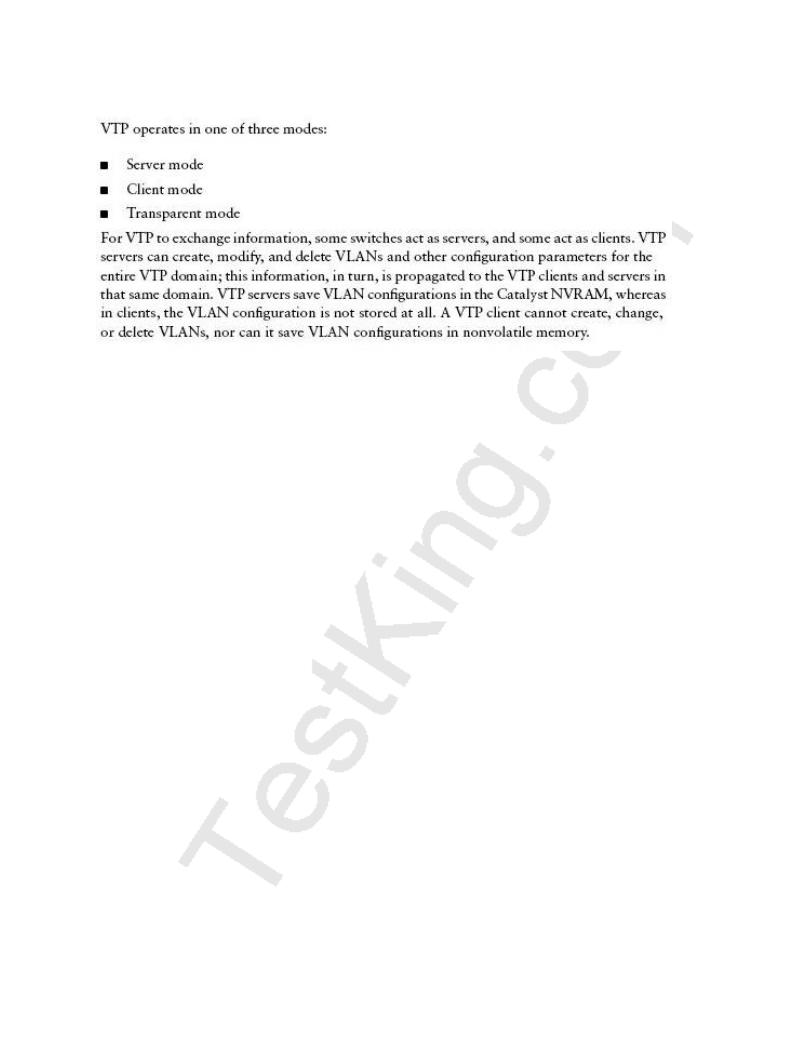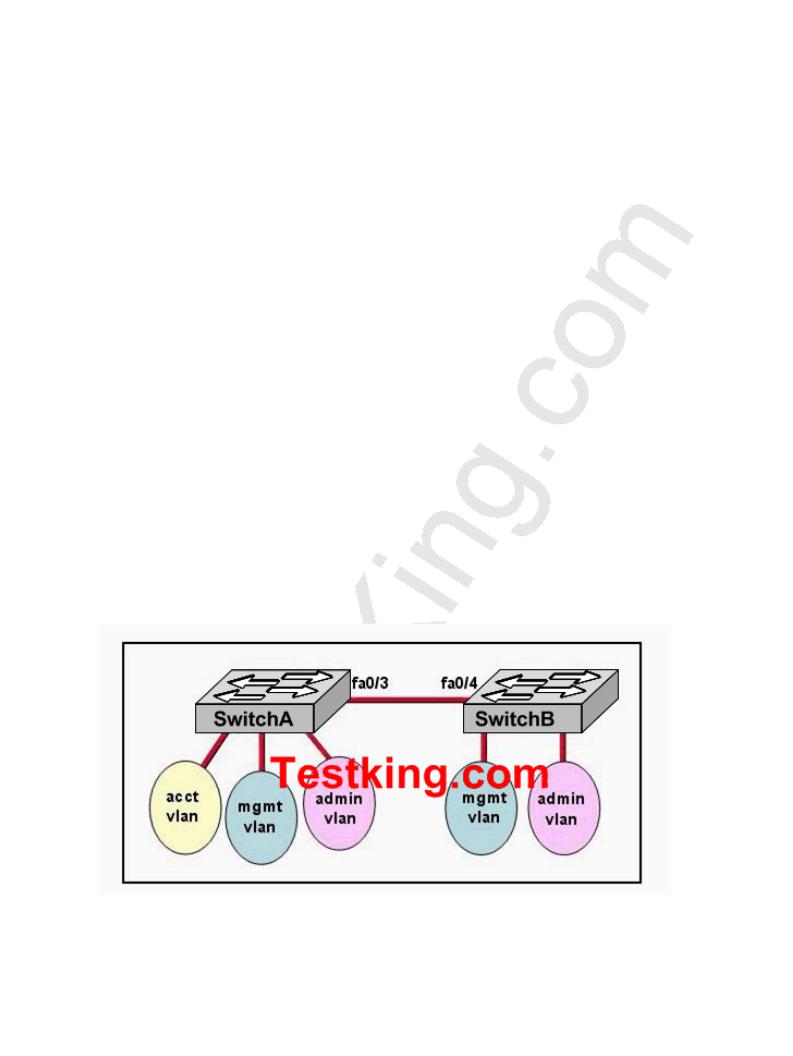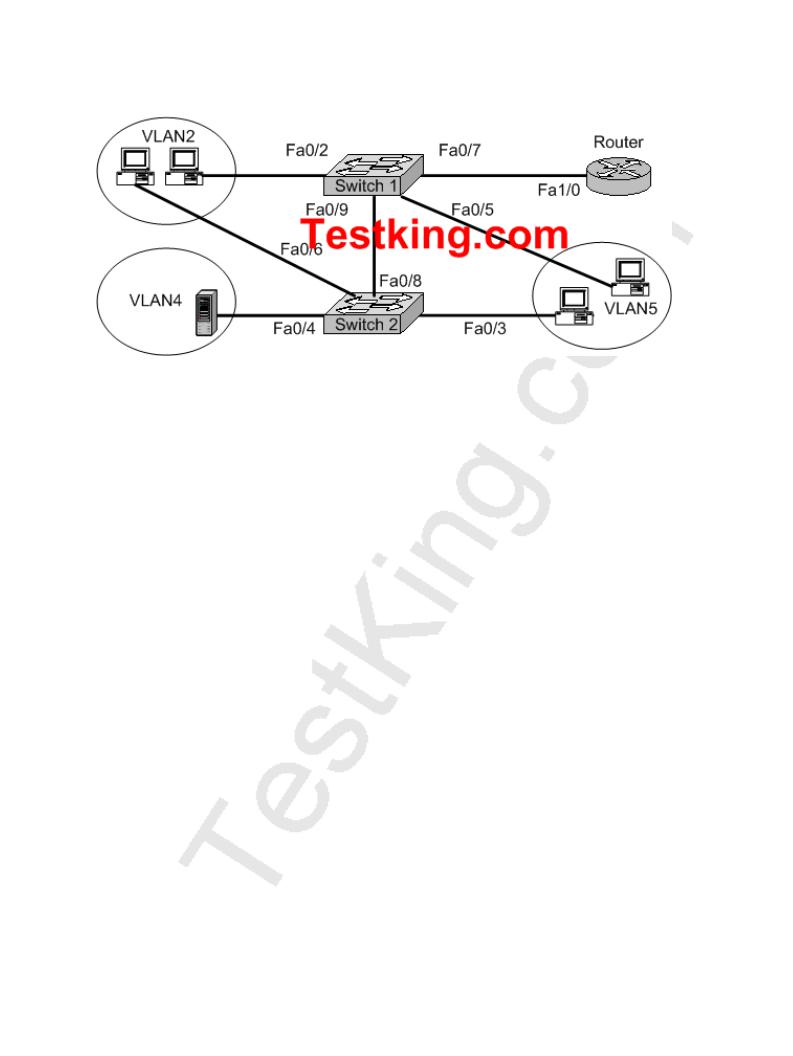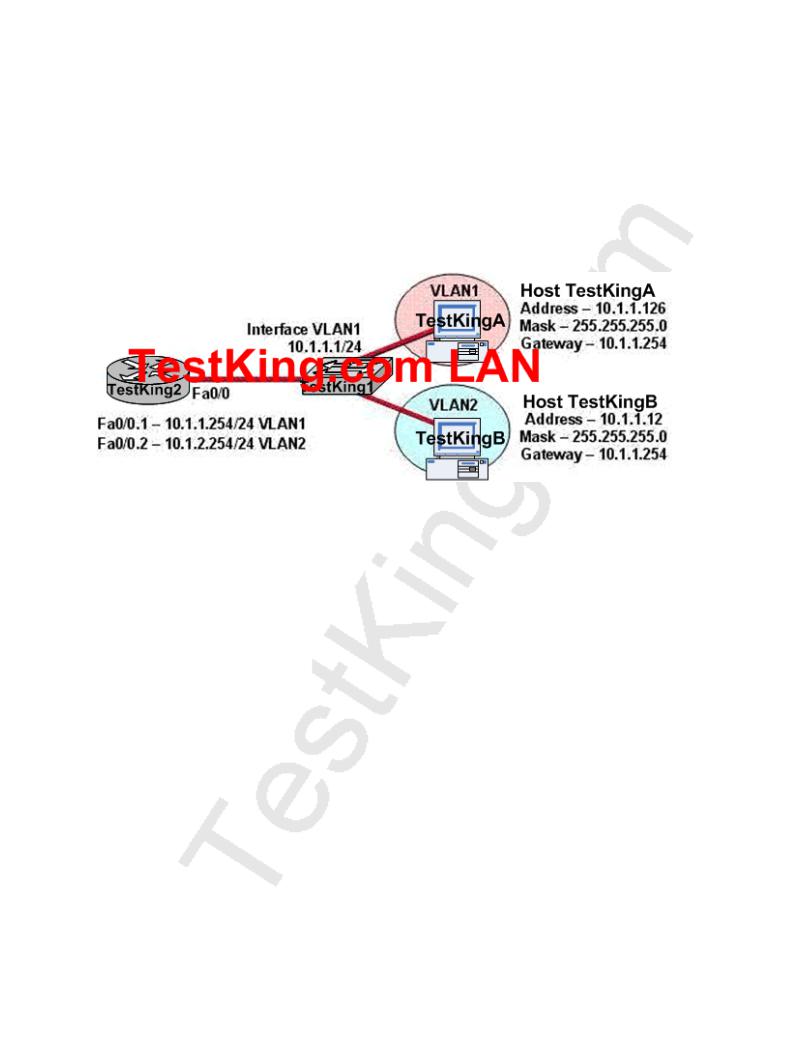
Testking_640-802_V13
.pdf
A.Switch(config)# switchport trunk encapsulation isl
B.Switch(config)# switchport trunk encapsulation ietf
C.Switch(config-if)# switchport trunk encapsulation isl
D.Switch(config-if)# switchport trunk encapsulation ietf
E.Switch(config-if)# switchport trunk encapsulation dot1q
Answer: E Explanation:
The only real choices for setting up switching trunks are ISL and 802.1Q. ISL is Cisco proprietary, while 802.1Q uses the IEEE defined standard for trunking between switches. To configure the 802.1Q standard, the keyword "dot1q" is used in Cisco switches.
Incorrect Answers:
A, B, D. These are not valid options in a Cisco switch.
C. ISL is a Cisco proprietary method for setting up trunks, and will only work between Cisco switches.
QUESTION NO: 5
A new switch is being installed in the TestKing network and you have been assigned the task of connecting it to an existing switch. In doing this, you want to set up the VLAN Trunking Protocol so that VLAN information can be passed between the switches. Which of the following must you do to accomplish this? (Choose all that apply).
A.You must set each end of the trunk line to IEEE 802.1e encapsulation.
B.You must set the same VTP management domain name on both switches.
C.You must set all ports on the two switches as access ports.
D.You must configure one of the switches as a VTP server.
E.You must use a rollover cable to connect the two switches.
Answer: B, D
Explanation:
The following describes what is needed in order to correctly set up VTP:
Leading the way in IT testing and certification tools, www.testking.com
- 211 -

Incorrect Answers:
A. The encapsulation can be either ISL or 802.1Q, and need to match at each end of the trunk.
C. Ports must only be assigned to VLANS. Once that is done and the trunk is up and running, the VLAN information will be passed between the switches.
E. A regular CAT5 cable is used to connect the switches, assuming 10/100 Ethernet is used.
QUESTION NO: 6
A new TestKing switch is installed into an existing LAN and a new VTP trunk is set up with an existing switch. Which VLANs will be allowed on this new trunk?
A.All defined VLANs are allowed on the trunk by default.
B.Each VLAN, or VLAN range, that is specified with the switchport mode command.
C.Each VLAN, or VLAN range, that is specified with the vtp domain command.
D.Each VLAN, or VLAN range, that is specified with the vlan database command.
E.None of the above
Answer: A Explanation:
The question does not state that there are multiple VTP Domains meaning that all defined VLANs are allowed on the trunk until a vtp domain command is issued.
Leading the way in IT testing and certification tools, www.testking.com
- 212 -

QUESTION NO: 7
You need to decide on which trunking method to implement in the TestKing network. What is a characteristic of ISL and 802.1q frame tagging in a switched LAN environment?
A.They are used to find the best path through a network.
B.They allow the exchange of filtering tables.
C.They specify different implementations of the Spanning-Tree Protocol.
D.They allow the exchange of routing tables
E.They provide inter-switch VLAN communication.
Answer: E
Explanation: A trunk link is the other type of Layer 2 port supported on Cisco switches. When a trunk port is configured, it begins marking frames as they
exit the port to indicate which VLAN each frame is associated with. The trunk port can also read the markings, called tags, as they enter the trunk port. This enables the switch to send a frame only to the ports for the given VLAN associated with the incoming frame.
The main purpose of trunking is to carry traffic between switches and maintain the VLAN information. Unlike an access link, the trunk link does not belong to a single VLAN but instead can carry traffic from several VLANs over a point-to-point link between two devices that understand the protocol. Two forms of trunking are used for Cisco switches on Ethernet networks:
An IEEE industry standard called IEEE 802.1Q. This is a frame-tagging mechanism that adds a VLAN identifier to the frame by inserting a tag at Layer 2.
Another form of trunking on Cisco switches is called Inter-Switch Link (ISL), which is a Cisco proprietary trunking mechanism. ISL uses a frame encapsulation method that adds a header to identify the VLAN.
Incorrect Answers:
A, D. These are the functions of routers, not switches.
B.Filtering tables can be used on certain Catalyst switches via the use of VLAN access control lists, but this information is never shared between switches.
C.A separate STP instance is created for each VLAN, but the STP implementation remains the same.
Leading the way in IT testing and certification tools, www.testking.com
- 213 -

QUESTION NO: 8
Which one of the following protocols allows the information about the configuration of a new VLAN to be distributed across entire switched network?
A.STP
B.VTP
C.EIGRP
D.SNMP
E.CDP
F.None of the above
Answer: B Explanation:
Sybex CCNA Study Guide 4th Edition states on page 359:
"The basic goals of VLAN Trunking Protocol (VTP) are to manage all configured VLANs across a switched internetwork and to maintain consistency throughout that network. VTP allows an administrator to add, delete, and rename VLANs-information that is then propagated to all other switches in the VTP domain."
Incorrect Answers:
A. STP is the Spanning Tree Protocol, used to prevent bridging loops in a LAN.
C.EIGRP is a routing protocol used to exchange routing information, not VLAN information.
D.SNMP is the Simple Network Management Protocol, used to provide information to remote network management stations.
E.CDP is the Cisco Discovery Protocol, which is used to exchange information between Cisco devices. It can only be used between Cisco routers and switches.
.
QUESTION NO: 9
Which encapsulation types are configurable on a Cisco switch for a trunk? (Select two answer choices)
A.VTP
B.ISL
C.CDP
D.802.1Q
E.802.1p
F.LLC
G.IETF
Leading the way in IT testing and certification tools, www.testking.com
- 214 -

Answer: B, D
Explanation:
Trunks are used to carry traffic belonging to multiple VLANs between devices over the same link. A device can determine which VLAN the traffic belongs to by its VLAN identifier. The VLAN identifier is a tag that is encapsulated with the data. ISL and 802.1q are two types of encapsulations used to carry data from multiple VLANs over trunk links. ISL is a Cisco proprietary protocol for interconnecting multiple switches and maintaining VLAN information as traffic goes between switches. ISL provides VLAN trunking capabilities while maintaining full wire speed performance on Ethernet links in full-duplex or half-duplex mode. ISL operates in a point-to-point environment and will support up to 1000 VLANs. In ISL, the original frame is encapsulated and an additional header is added before the frame is carried over a trunk link. At the receiving end, the header is removed and the frame is forwarded to the assigned VLAN. .ISL uses Per VLAN Spanning Tree (PVST) which runs one instance of Spanning Tree Protocol (STP) per VLAN. PVST allows for optimal root switch placement for each VLAN and supports load balancing of VLANs over multiple trunk links.
802.1Q is the IEEE standard for tagging frames on a trunk and supports up to 4096 VLANs. In 802.1Q, the trunking device inserts a four-byte tag into the original frame and re-computes the Frame Check Sequence (FCS) before sending the frame over the trunk link. At the receiving end, the tag is removed and the frame is forwarded to the assigned VLAN. 802.1Q does not tag frames on the native VLAN. It tags all other frames transmitted and received on the trunk. While configuring a 802.1 trunk, you must make sure that the same native VLAN is configured on both sides of the trunk. IEEE 802.1Q defines a single instance of spanning tree running on the native VLAN for all the VLANs in the network which is called Mono Spanning Tree (MST). This lacks the flexibility and load balancing capability of PVST available with ISL. However, PVST+ offers the capability to retain multiple Spanning Tree topologies with 802.1Q trunking.
QUESTION NO: 10
You need to configure an 802.1Q link on a TestKing switch. Which commands, when used together, would do this? (Select two answer choices)
A.Switch(vlan)# mode trunk
B.Switch(config)# switchport access mode trunk
C.Switch(config-if)# switchport mode trunk
D.Switch(config-if)# switchport trunk encapsulation dot1q
E.Switch(config)# switchport access mode 1
F.Switch(vlan)# trunk encapsulation dot1q
Leading the way in IT testing and certification tools, www.testking.com
- 215 -

Answer: C, D
Explanation:
Creating this trunk link is a two step process. First you have to set the switchport mode to trunk, and then you configure the encapsulation. The giveaway on this question is the fact that to create a trunk on an interface, you have to be in interface configuration mode. So switchport mode trunk sets the trunk, and switchport trunk encapsulation dot1q sets the encapsulation.
QUESTION NO: 11
Which of the following are VLAN frame encapsulation types that may be configured on a Catalyst switch? (Choose two.)
A.VTP
B.ISL
C.CDP
D.802.1Q
E.802.1p
F.LLC
Answer: B, D
Explanation:
The two VLAN trunking encapsulation types are:
Inter-Switch Link (ISL): This is proprietary to Cisco switches, and it's used for Fast Ethernet and Gigabit Ethernet links only. ISL routing can be used on a switch port, router interfaces, and server interface cards to trunk a server. ISL lets you explicitly tag VLAN information onto an Ethernet frame. This tagging information allows VLANs to be multiplexed over a trunk link through an external encapsulation method, which allows the switch to identify the VLAN membership of a frame over the trunked link.
IEEE 802.1Q: Created by the IEEE as a standard method of frame tagging, this actually inserts a field into the frame to identify the VLAN. If you're trunking between a Cisco switched link and a different brand of switch, you have to use 802.1Q for the trunk to work.
QUESTION NO: 12
Leading the way in IT testing and certification tools, www.testking.com
- 216 -

There are 2 switches in the Testking LAN, with no routers. Ports 1, 2 & 3 are assigned to VLAN 1 in switch 1 and 2 and ports 4, 5 & 6 are assigned to VLAN 2 in both switches. These two switches are connected together via a trunked link. Which of the conditions below would verify trunk and VLAN operation? (Select all valid answers)
A.Host 1 on VLAN 1 can ping Host 2 on VLAN 1
B.Host 1 on VLAN 1 can ping Host 4 on VLAN 2
C.Host 1 on VLAN 1 can not ping Host 2 on VLAN 1
D.Host 4 on VLAN 2 can not ping Host 1 on VLAN 1
E.Host 4 on VLAN 2 can ping Host 2 on VLAN 2
Answer: A, D, E Explanation:
If there is no router present, only hosts in the same VLAN will be able to ping each other. In order for any host on one VLAN to communicate with a host on another VLAN, the traffic must pass through a router. Host within the same VLAN will be able to ping each other, even though they reside on different switches, as long as the switches have a trunk connection configured between them.
QUESTION NO: 13
Two TestKing switches are connected as shown below:
Leading the way in IT testing and certification tools, www.testking.com
- 217 -

Please study the exhibit carefully. Configuration of both switches has been completed. During testing, the network administrator notices that users on SwitchA can not connect with users in the same VLAN on SwitchB. What should be done to solve this problem?
A.Ensure that the IP address of SwitchA is on the same network as the IP address of SwitchB.
B.Ensure that the same interface number is used to connect both switches.
C.Ensure that the ports connecting the two switches are configured to trunk.
D.Ensure that SwitchA and SwitchB are connected with a straight-through cable.
Answer: C Explanation:
Ports can be in two states on a switch:
Access ports: This type of link is only part of one VLAN, and it's referred to as the native VLAN of the port. Any device attached to an access link is unaware of a VLAN membership the device just assumes it's part of a broadcast domain, but it does not understand the physical network.
Trunk links: Trunks can carry multiple VLANs and originally gained their name after the telephone system trunks that carry multiple telephone conversations.
So to carry the VLAN information from one switch to another switch, a trunk link needs to be configured between the two switches, using the "showtchport mode trunk" command.
Note: By default all ports are in access mode.
QUESTION NO: 14
The TestKing network is displayed in the diagram below:
Leading the way in IT testing and certification tools, www.testking.com
- 218 -

A network associate is trying to understand the operation of the TestKing network by studying the graphic. All hosts are able to reach the enterprise server on VLAN4. The associate needs to determine which interfaces are functioning as a trunk ports. Which of the interfaces are trunks? (Choose two)
A.Switch1 - Fa0/2
B.Switch1 - Fa0/9
C.Switch2 - Fa0/3
D.Switch2 - Fa0/4
E.Switch2 - Fa0/6
F.Router - Fa1/0
Answer: B, F
Explanation:
Trunks are only used on connections between two switches, or between routers and switches. Trunk ports are not used on connections to end stations, such as servers or computer stations. In this example, only choice B and F are possible trunks.
Leading the way in IT testing and certification tools, www.testking.com
- 219 -

Section 12: Configure, verify, and troubleshoot interVLAN routing (8 questions)
QUESTION NO: 1
Two TestKing hosts reside in different VLANs as shown below:
The TestKing network shown in the diagram above is experiencing connectivity problems. Which of the following will correct the problems? (Choose two.)
A.Configure the gateway on Host TestKingA as 10.1.1.1
B.Configure the IP Address of Host TestKingB as 10.1.2.2
C.Configure the IP Address of Host TestKingA as 10.1.2.2
D.Configure the gateway on host TestKingB as 10.1.2.254
Answer: B, D
QUESTION NO: 2
A TestKing network is shown below:
Leading the way in IT testing and certification tools, www.testking.com
- 220 -
